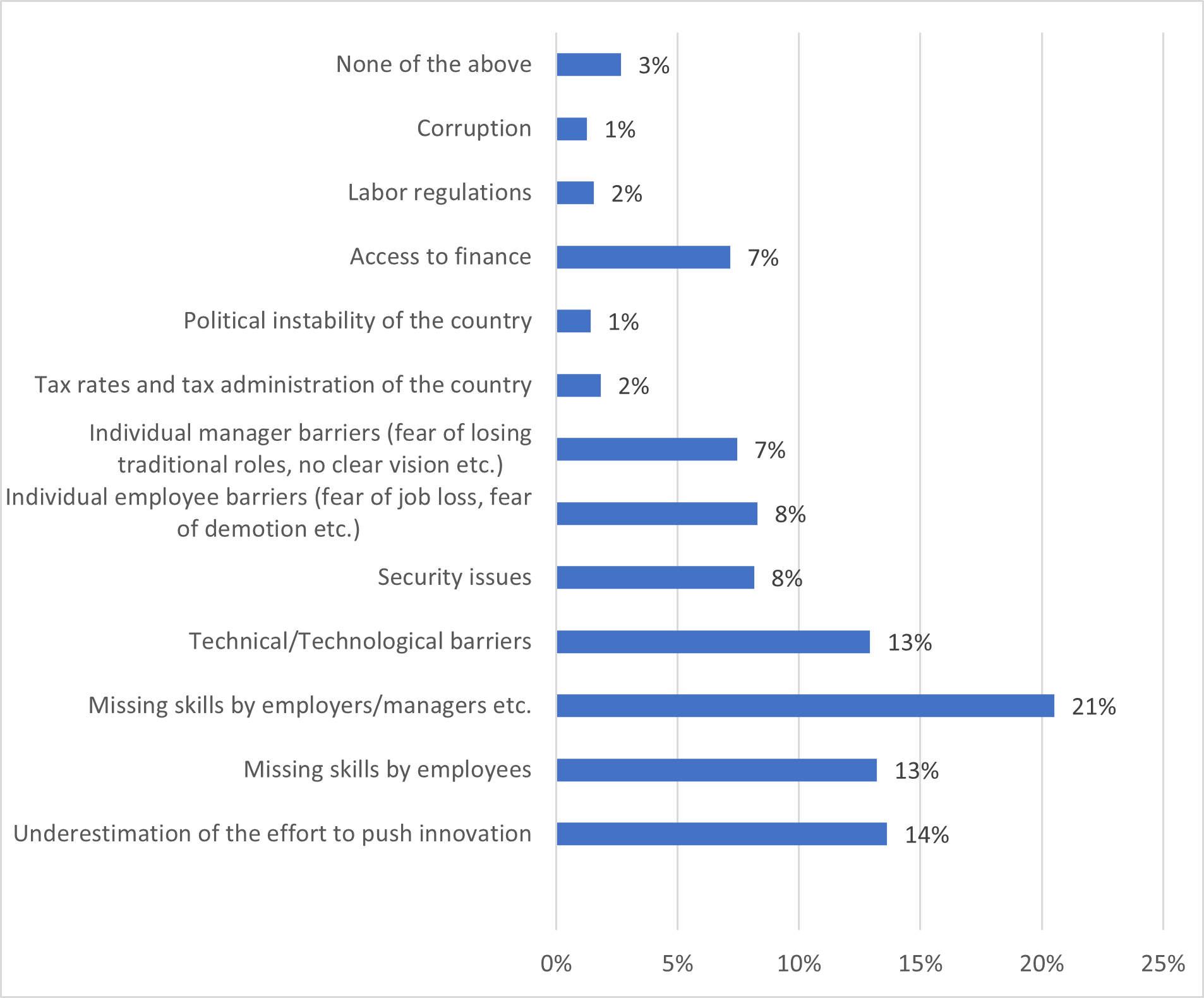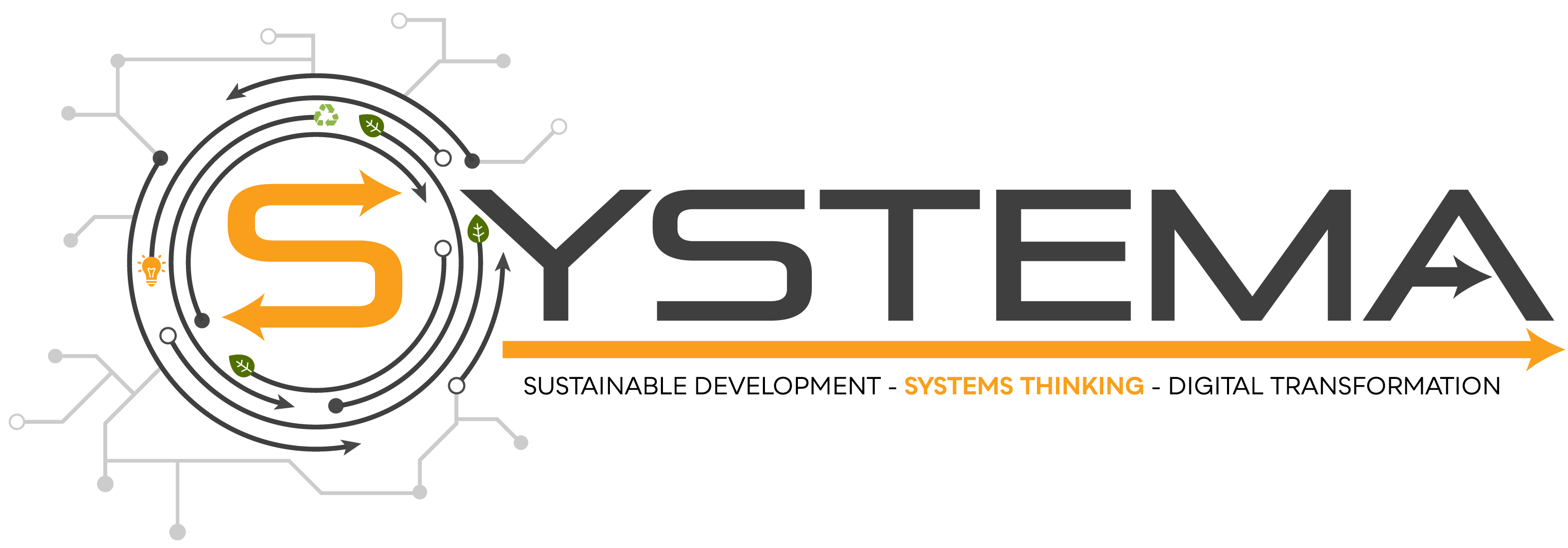The characteristic of the modern world is that it has entered a digital era, identified by accelerating technological innovations, shifts in the way people live, transact and socialise. This Fourth Industrial Revolution has been achieved by advances in Big Data and Artificial Intelligence and has caused consequences in industries, societies and governments.
A report by the World Economic Forum (2018) has indicated that SMEs need to embrace Digital Transformation in order to become sustainable. This implies that SMEs need to:
- Fundamentally change their business models
- Digitize their operating models
- Attract and retail people with the necessary, diverse skills to succeed in the Fourth Industrial Revolution
- Develop new digital metrics of success
Hence, not only digitization but Digital Transformation (DT) should be the goal of SMEs and organizations in general in order to succeed in the new world that is emerging. Digital transformation can be defined as:
Increasing application of digitization and/or automation that has important impacts on structure or characteristics of individual work, internal processes, communication, infrastructure, business ecosystems and products/services for internal and/or external customers. The core of Digital Transformation is the overall digitization and cross-linking of the value creation process.
As a result, digital transformation means adopting a broader mindset that encompasses Big Data, cutting-edge technology and human-centered design which has the potential to transform traditional business models. Adopting digital transformation does not solely mean to use digital means but it requires the synergy of multiple actors to innovate and create value across the ecosystem find a new way of combining products and services, offer competitive advantages to businesses and optimize their processes and change the meaning of productivity, thus creating the opportunities for wide range impact across all economic sectors and the society.
Digital Transformation, moreover, is not limited to a sector. It includes public and private institutions, it involves business managers and public policy makers and it relies heavily on the acquisition of a new set of skills by both employers and employees. The figure below summarizes how the EU views Digital Transformation for the next decade.

Digital Compass by the EU
However, several barriers have been and continue to be encountered by managers and policy makers in their effort to achieve Digital Transformation. In the context of the SYSTEMA project, a survey was developed, and the respondents indicated which of the barriers they encounter often.

Hence, several lessons can be taught about Digital Transformation:
- It is a Complex process
- It involves many processes of an organization
- It is centered on human behavior, abilities and skills
- Both external and internal factors could hinder the transition
- It involves different stakeholders with different objectives
Thus, when it comes to a complex change process like the one of Digital Transformation (or Sustainable Development), there is the need to tackle and manage it through a different approach that allows embracing the complexity of the systems under study: one of these approaches is Systems Thinking.
In fact, Systems Thinking can be applied broadly and in a variety of fields, and is particularly recommended when the domain under analysis has some of the following characteristics
- the issue is relevant;
- several parts of the system interact giving rise to the specific behavior (or problem) under analysis;
- the problem to be faced is not easy to analyze, and might have been determined by causes distant in space and time;
- trade-offs among possible solutions may exist.
Overall, we need Systems Thinking for a number of reasons that are quite general (Maani and Cavana, 2000, p. 5) and that consist in the following aspects:
- the increasing complexity of our lives;
- the growing interdependencies of the world;
- the revolutions in management theories and practice;
- the increasing “global” consciousness and yet “local” decision-making;
- the increasing recognition of learning as a key organizational capability”.
But what is Systems Thinking? Daniel Kim (1999, p. 2) argues that it is “a way of seeing and talking about reality that helps us better understand and work with systems to influence the quality of our lives. (…). It also involves a unique vocabulary for describing systemic behavior, and so can be thought of as a language as well”.
Therefore, Systems Thinking can be seen from different perspectives. It is a holistic approach to analyzing how systems work and can be managed; it is also a set of techniques and tools that will support analysts, learners, and decision-makers in facing problem-solving tasks and complex issues. And, to a certain extent, Systems Thinking can be also seen as a skill or even a “discipline” in itself (see Peter Senge and his well-known book titled “The Fifth Discipline”, 1990).
Another excellent definition has been given by Barry Richmond (1994) and states that Systems Thinking is the art and science of making reliable inferences about behavior by developing an increasingly deep understanding of underlying structure. In particular, the “art and science” is constituted by the coexistence of a new Thinking Paradigm with a Learning Method. The first conditions the second. The second supports the first. The two parts form a synergistic whole. The paradigm is characterized by the availability of the Vantage Point perspective and a set of Thinking Skills (namely: System as Cause Thinking, Closed-loop Thinking and Operational Thinking) whereas the Learning Method implies sharing a view on the processes at stake, a common language to define things and a supporting technology (i.e. System Dynamics simulation).
As a result, Systems Thinking (and System Dynamics, as it’s quantitative declination) are ideal candidates to assist in a successful Digital Transformation:
They allow in fact carrying out more effectively the analysis of large-scale systems: Systems Thinking and System Dynamics are the two faces of a same new thinking framework: a qualitative and quantitative approach that allows for the representation of any type of system from a holistic point of view. In particular, as mentioned above, they offer the possibility to assist in the process of understanding how the system’s structure could affect its behavior and find those factors that causally affect important aspects.
Additionally, they are easy to use and communicate: by being a way of thinking and a mathematical methodology, Systems Thinking is based on feedback loops, non-linearities and time delays. However, these aspects can be represented and understood with Causal Loop Diagrams that are theoretical maps of the main elements of the system under study and their causal relations. Consequently, even with that theoretical tool, policy makers and different stakeholders can explicitly see where they agree, where they disagree and how potential policies could affect the entire system. Equally important, these maps can be used to communicate policies to the general public, thus making the whole decision-making process more transparent. Finally, they allow for the experimentation of different scenarios and “what if” analyses:
Thanks to all the features that were mentioned above, Systems Thinking and System Dynamics can be used for experimentation by policy makers. Thus, different scenarios could illustrate the bottlenecks in the system, how countermeasures could exhibit counter-intuitive consequences and which levers are ideal to achieve the desired objectives. The reason for which this happens is because System Dynamics is a methodology that compresses time and space, which offers the possibility to test potential policies (no matter how far-fetched or expensive) in a consequence-free environment.
In conclusion, Digital Transformation can be a source of success and sustainability, but for it to be successful, an organisation needs to become a learning organisation (Senge, 1990) which can be the only type of organisation that thrives during the digital transformation. However, the nature of Digital Transformation means that traditional models which rely on linearities and equilibria might not be suitable (Forrester, 2003). Furthermore, the prominent role of people’s behaviour (through skills, resistance to change, willingness to learn etc.) have to be included. Finally, Digital Transformation could have long-term consequences, meaning that delays should be introduced between when a potential policy is applied and when its consequences could appear. Hence, Systems Thinking and System Dynamics are great candidates to assist policy makers to successfully achieve Digital Transformation. However, more practical applications are necessary in the domain of Digital Transformation. A Systems Thinking course/curriculum/training could assist managers, students, employees etc. to better understand how Digital Transformation can help them and their organisation, thus equipping them with the skills to better structure their decision-making process and that is the purpose of the SYSTEMA project.In conclusion, Digital Transformation can be a source of success and sustainability, but for it to be successful, an organisation needs to become a learning organisation (Senge, 1990) which can be the only type of organisation that thrives during the digital transformation. However, the nature of Digital Transformation means that traditional models which rely on linearities and equilibria might not be suitable (Forrester, 2003). Furthermore, the prominent role of people’s behaviour (through skills, resistance to change, willingness to learn etc.) have to be included. Finally, Digital Transformation could have long-term consequences, meaning that delays should be introduced between when a potential policy is applied and when its consequences could appear. Hence, Systems Thinking and System Dynamics are great candidates to assist policy makers to successfully achieve Digital Transformation. However, more practical applications are necessary in the domain of Digital Transformation. A Systems Thinking course/curriculum/training could assist managers, students, employees etc. to better understand how Digital Transformation can help them and their organisation, thus equipping them with the skills to better structure their decision-making process and that is the purpose of the SYSTEMA.

